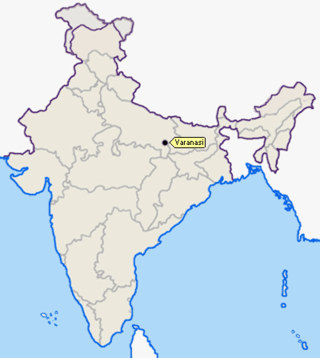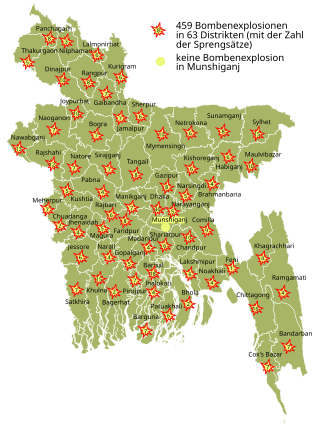The Students' Islamic Movement of India is a banned terrorist organisation that was formed in Aligarh, Uttar Pradesh in April 1977. The stated mission of SIMI is the ‘liberation of India’ by converting it to an Islamic land. The SIMI, an organisation of extremists has declared Jihad against India, the aim of which is to establish Dar-ul-Islam by either forcefully converting everyone to Islam or by violence. The Indian government describes it as a terrorist organisation, and banned it in 2001, shortly after the 9/11 attacks. The ban was lifted in August 2008 by a special tribunal, but was reinstated by K.G. Balakrishnan, then Chief Justice, on 6 August 2008 on national security grounds.

Siddique ul-Islam, known popularly as Bangla Bhai, also known as Jawad uddin attariAzizur Rôhman, was a Bangladeshi terrorist and the military commander of the Al Qaeda affiliated radical Islamist organization Jagrata Muslim Janata Bangladesh, known in popular usage as the JMJB. Most active in the north-western section of Bangladesh around the Rajshahi region, Bangla Bhai gained a nationwide and worldwide notoriety for bombings and other terrorist activities.
On 17 August 2005, around 500 bomb explosions occurred at 300 locations in 63 out of the 64 districts of Bangladesh. The bombs exploded within a half-hour period starting from 11:30 am. A terrorist organization, Jama'atul Mujahideen Bangladesh (JMB) claimed responsibility for the bombings. The group, led by Shaykh Abdur Rahman and Siddiqur Rahman. Another terrorist group, named Harkat-ul-Jihad al-Islami, was associated with JMB in executing the co-ordinated attack. Following the bombings, both groups were banned by the BNP Government of Bangladesh.

The 2005 Delhi bombings occurred on 29 October 2005 in Delhi, India, killing 62 people and injuring at least 210 others in three explosions. The bombings came only two days before the important festival of Diwali, which is celebrated by Hindus, Sikhs, and Jains. The bombs were triggered in two markets in central and south Delhi and in a bus south of the city. The Pakistani Islamist terrorist group Lashkar-e-Taiba claimed responsibility for the attacks under the pseudonym of Islamic Inquilab Mahaz. The Indian Mujahideen is also suspected of involvement.

Jamaat-ul-Mujahideen is a terrorist organisation operating in Bangladesh. It is listed as a terror group by Bangladesh, India, Malaysia and the United Kingdom. It was founded in April 1998 in Palampur in Dhaka Division by Abdur Rahman and gained public prominence in 2001 when bombs and documents detailing the activities of the organisation were discovered in Parbatipur in Dinajpur district. The organisation was officially declared a terrorist organisation and banned by the government of Bangladesh in February 2005 after attacks on NGOs. But it struck back in mid-August when it detonated 500 small bombs at 300 locations throughout Bangladesh. The group re-organised and has committed several public murders in 2016 in northern Bangladesh as part of a wave of attacks on secularists.
Indian Mujahideen (IM) is an Islamist terrorist group which has been particularly active in India. The jihadist group was founded as an offshoot of the Students' Islamic Movement of India (SIMI) by several radicalized members including Iqbal Bhatkal, Riyaz Bhatkal, Yasin Bhatkal, Abdul Subhan Qureshi, Amir Reza Khan and Sadiq Israr Sheikh, among others. It has been active since at least 2005 when it bombed the Dashashwamedh Ghat in Varanasi. It carried out several serial-bombings in Indian cities in the following years notably the 2007 Uttar Pradesh bombings, 2008 Jaipur bombings, 2008 Ahmedabad bombings, 2008 Delhi bombings, 2010 Pune bombing, 2011 Mumbai bombings, 2011 Delhi bombing, 2013 Patna bombings, 2013 Hyderabad blasts and the 2013 Bodh Gaya bombings.

The 2010 Varanasi bombing was a blast that occurred on 7 December 2010, in one of the holiest Hindu cities, Varanasi. The explosion occurred at Sheetla Ghat, adjacent to the main Dashashwamedh Ghat, where the sunset aarti, the evening prayer ritual to the holy river, Ganges had commenced, on these stone steps leading to it, where thousands of worshipers and tourists had gathered. It killed a two-year-old girl, sitting on her mother's lap, the mother was one of three critically injured, more than 38 other people were injured. In the ensuing panic after the blast, a railing broke causing a stampede leading to an increase in the number of injuries. The bomb was hidden inside a milk container on the Sheetla Ghat. The blast occurred a day after the anniversary of the 1992 Babri Masjid demolition, in which a mosque was demolished at Ayodhya leading to nationwide religious riots killing over 2,000 people. Subsequently, the Islamist militant group, Indian Mujahideen, claimed responsibility of the blast, via email to Indian media. This is also the second terrorism-related incident in the city which was rocked by the serial blasts of 2006, in which 28 people were killed, it included an explosion at the Sankatmochan Temple, some two kilometres away.

The 2011 Mumbai bombings, also known as 13/7, were a series of three coordinated bomb explosions at different locations in Mumbai, India, on 13 July 2011 between 18:54 and 19:06 IST. The blasts occurred at the Opera House, at Zaveri Bazaar and at Dadar West localities, leaving 26 killed and 130 injured. Indian Mujahideen is believed to have carried out the attack with the personal involvement of its co-founder Yasin Bhatkal.
The 2011 Delhi bombing took place in the Indian capital Delhi on Wednesday, 7 September 2011 at 10:14 local time outside Gate No. 5 of the Delhi High Court, where a suspected briefcase bomb was planted. The blast killed 15 people and injured 79. Harkat-ul-Jihad al-Islami claimed responsibility for the attack, and is believed to have carried out the attack with support from the Indian Mujahideen, it stated motive was the commuting of the death sentence for 2001 Indian Parliament attack convict Afzal Guru.
Shah Riyaz Ahmad Mohammed Ismail Shahbandari, known as Riyaz Bhatkal, is the co-founder, leader and a wanted terrorist of Indian Mujahideen, a terrorist group based in India. Riyaz Ismail Shahbandri is one of the Indian Mujahideen's three top commanders and is currently based in Karachi, Pakistan along with his brother Iqbal Bhatkal.

The 2012 Pune bombings was a series of four coordinated low-intensity bombing attacks that occurred on 1 August 2012 across Pune, the ninth-largest metropolis in India. As of October 2012, Indian Mujahideen, a terrorist group based in India, is suspected to be behind the attacks.
Syed Mohammed Ahmed Zarar Siddibappa, known as Yasin Bhatkal, is a convicted Indian Islamist terrorist, who was the co-founder and leader of the proscribed terrorist organisation Indian Mujahideen (IM). Yasin along with Riyaz Bhatkal and Iqbal Bhatkal, among others, founded the terrorist organisation around 2005. The jihadist group has carried out several attacks against civilian targets in India and Yasin was notably personally involved in the 2010 Pune bombing, 2010 Bangalore stadium bombing, 2011 Mumbai bombings, 2012 Pune bombings and the 2013 Hyderabad blasts.

On 21 February 2013, at around 19:00 IST, two blasts occurred in the city of Hyderabad, India. The bombs exploded in Dilsukhnagar, a crowded shopping area, within 100 metres (330 ft) of each other. The first explosion occurred outside a roadside eatery named A1 Mirchi, next to the Anand Tiffin Centre and opposite the Konark movie hall, followed by the second one two minutes later near the Route 107 bus stand close to the Venkatadri theatre. In December 2016, Yasin Bhatkal - the co-founder of Indian Mujahideen, Pakistani national Zia-ur-Rahman, Asadullah Akhtar, Tahaseen Akhtar, and Ajaz Shaikh were given a death-sentence by a National Investigation Agency special court for carrying out the attacks under the Arms Act, Explosive Substances Act and Prevention of Damage to Public Property Act.

On 7 July 2013 a series of ten bombs exploded in and around the Mahabodhi Temple complex, a UNESCO World Heritage Site in Bodh Gaya, India. Five people, including two Buddhist monks, were injured by the blasts. Three other devices were defused by bomb-disposal squads at a number of locations in Gaya.

On 27 October 2013, a series of bomb blasts rocked the Indian city of Patna, Bihar at a massive election rally for Prime Minister Narendra Modi, then the Bharatiya Janata Party candidate for prime minister. Of the estimated 300,000 participants at the "Hunkar" rally, six people were killed and 85 others were injured in eight bomb blasts.

Bangladesh has experienced terrorism in the past conducted by a number of different organizations. In the past, both ISIL and other terrorist organizations had claimed to be active in the country however, the Bangladeshi government believes that they mainly operated through local affiliates, before being neutralised by security forces.
2005 November Bangladesh court bombing was a simultaneous suicide bombing of courts in Chittagong and Gazipur in Bangladesh carried out by Jamaat-ul-Mujahideen Bangladesh on 29 November 2005 that killed 8 people and injured over 100.
2005 October Bangladesh court bombing was a synchronized bombing on 3 October 2005 that targeted courts in Chandpur and Lakshmipur and resulted in 2 deaths and 34 injuries. It was carried out by Jamaat-ul-Mujahideen Bangladesh, an Islamist terrorist organisation, that opposed the secular judiciary and legal system in Bangladesh.
The 2005 Netrokona bombing was a suicide bomb attack on 8 December 2005 in Netrokona, Bangladesh that resulted in the deaths of eight people. It took place mid-morning outside the offices of Bangladesh Udichi Shilpigoshthi, a secular cultural organisation.

Islamic State – Bengal Province (IS-BP) is an administrative division of the Islamic State, a Salafi jihadist militant group and former unrecognised Quasi-state. The group was announced by ISIL as its province in 2016. The first emir of Wilayat al-Bengal, Abu Ibrahim al-Hanif, is believed to be Mohammad Saifullah Ozaki a Bangladeshi Japanese economist who went to Syria in 2015 and joined IS. A Hindu convert to Islam, he reportedly lead the 2016 Dhaka attack. He was detained in Iraq in 2019 and Abu Muhammed al-Bengali was announced as the new emir of the province.











